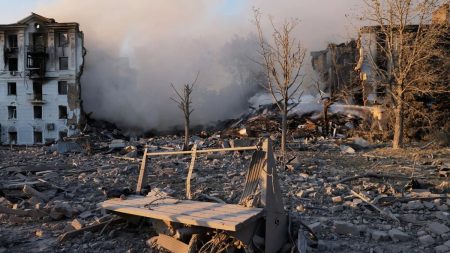Storm Darragh, a powerful weather system characterized by high winds and heavy rain, wreaked havoc across the UK and Ireland, leaving a trail of destruction and disruption in its wake. The storm’s intensity prompted authorities to issue a rare emergency alert to approximately three million households in Wales and southwest England, a stark testament to the severity of the impending weather event. This alert, accompanied by a piercing siren-like sound, urged residents to take shelter indoors as the storm unleashed its fury. The storm’s impact was tragically underscored by the loss of two lives, both victims of falling trees amidst the tempestuous conditions. One fatality occurred near Preston in northwest England, where a man in his 40s lost his life when a tree crushed his van on a highway. A similar incident claimed the life of another man in Birmingham’s Erdington area, highlighting the dangers posed by the storm’s powerful gusts.
The ferocity of Storm Darragh was evident in the widespread power outages that plunged hundreds of thousands of homes into darkness across the affected regions. Northern Ireland, Wales, and western England bore the brunt of these outages, leaving communities without electricity and essential services. Major transportation arteries, including highways and bridges, were forced to close due to the hazardous conditions created by the storm’s high winds. Train services also experienced significant disruptions, with numerous cancellations and delays impacting travel plans. The storm’s impact extended beyond land, affecting air travel as well, with cancellations reported at Dublin Airport. The Met Office, the UK’s primary weather forecasting agency, had issued a red weather warning in anticipation of the storm’s arrival, underscoring the severity of the situation.
Storm Darragh’s powerful winds, reaching speeds of up to 149 kilometers per hour, uprooted trees, damaged infrastructure, and caused widespread disruption. The emergency alert system, employed due to the exceptional nature of the storm, played a crucial role in disseminating vital warnings to vulnerable populations. The tragic loss of life served as a grim reminder of the inherent dangers associated with severe weather events and the importance of heeding official warnings. The widespread power outages underscored the vulnerability of power grids to extreme weather conditions and the challenges faced by utility companies in restoring services amidst the storm’s aftermath. The closure of major transportation routes highlighted the storm’s impact on mobility and the prioritization of public safety during such events.
The response to Storm Darragh involved a coordinated effort between meteorological agencies, emergency services, and government authorities. The Met Office’s timely issuance of weather warnings provided crucial information to the public, enabling individuals and communities to prepare for the impending storm. Emergency services were mobilized to respond to incidents related to the storm, including rescuing individuals trapped by fallen trees and providing assistance to those affected by power outages. Government agencies played a vital role in coordinating the overall response and ensuring the dissemination of critical information to the public. The deployment of the emergency alert system demonstrated the utilization of technology to enhance public safety during severe weather events.
Beyond the immediate impact of Storm Darragh, the storm also served as a reminder of the increasing frequency and intensity of extreme weather events, potentially linked to climate change. The storm’s destructive power underscored the need for greater preparedness and resilience in the face of such events. The widespread disruption caused by Storm Darragh emphasized the importance of investing in robust infrastructure that can withstand the impacts of extreme weather. The storm also highlighted the need for effective communication strategies to ensure that timely and accurate information reaches vulnerable populations.
In the aftermath of Storm Darragh, communities began the arduous process of recovery and rebuilding. Efforts focused on restoring power to affected areas, clearing debris from roads and highways, and assessing the extent of the damage. The storm’s impact on transportation infrastructure required significant repairs and restoration work. The economic consequences of the storm, including damage to property and businesses, were also assessed. The experience of Storm Darragh served as a valuable lesson in the importance of preparedness, resilience, and community collaboration in the face of extreme weather events.














